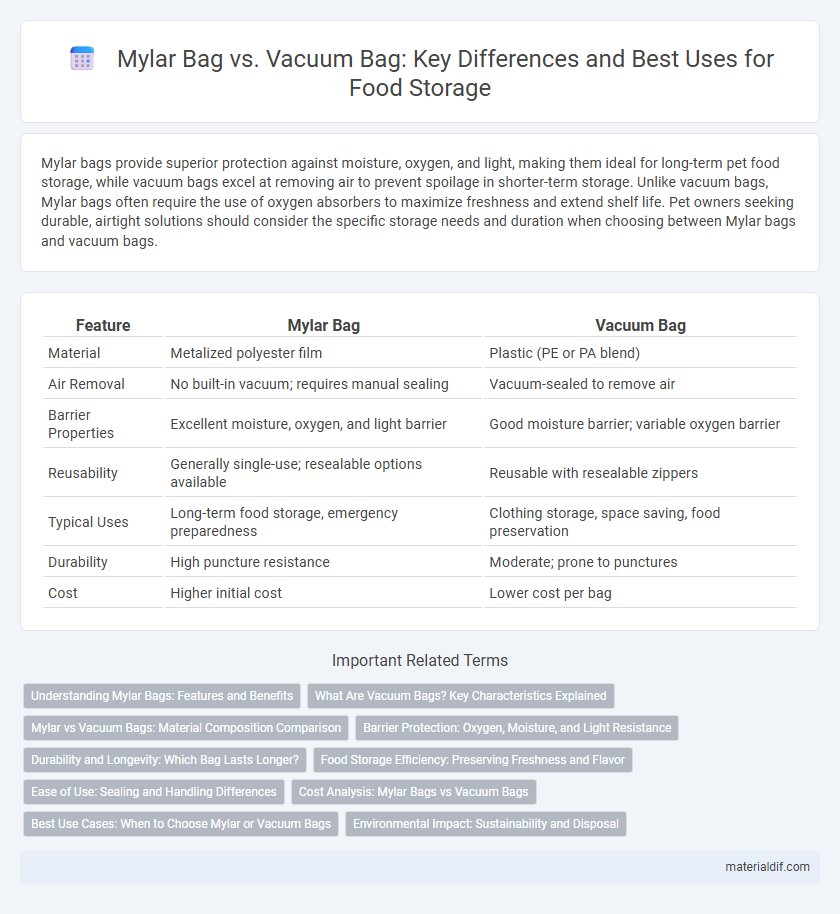Mylar bags provide superior protection against moisture, oxygen, and light, making them ideal for long-term pet food storage, while vacuum bags excel at removing air to prevent spoilage in shorter-term storage. Unlike vacuum bags, Mylar bags often require the use of oxygen absorbers to maximize freshness and extend shelf life. Pet owners seeking durable, airtight solutions should consider the specific storage needs and duration when choosing between Mylar bags and vacuum bags.
Table of Comparison
| Feature | Mylar Bag | Vacuum Bag |
|---|---|---|
| Material | Metalized polyester film | Plastic (PE or PA blend) |
| Air Removal | No built-in vacuum; requires manual sealing | Vacuum-sealed to remove air |
| Barrier Properties | Excellent moisture, oxygen, and light barrier | Good moisture barrier; variable oxygen barrier |
| Reusability | Generally single-use; resealable options available | Reusable with resealable zippers |
| Typical Uses | Long-term food storage, emergency preparedness | Clothing storage, space saving, food preservation |
| Durability | High puncture resistance | Moderate; prone to punctures |
| Cost | Higher initial cost | Lower cost per bag |
Understanding Mylar Bags: Features and Benefits
Mylar bags are made from biaxially-oriented polyethylene terephthalate (BoPET), offering superior barrier properties against moisture, oxygen, and light, which extends the shelf life of stored items significantly. Unlike vacuum bags, Mylar bags maintain a strong seal even without removing air, providing durable protection for long-term storage of food, electronics, and pharmaceuticals. Their high tensile strength, puncture resistance, and compatibility with oxygen absorbers make Mylar bags an ideal choice for preserving freshness and preventing spoilage.
What Are Vacuum Bags? Key Characteristics Explained
Vacuum bags are airtight storage solutions designed to remove air and prevent moisture, dust, and air exposure, which helps preserve the contents for extended periods. They are typically made from multi-layered plastic materials, including Mylar, polyethylene, and nylon, providing durability, puncture resistance, and high-barrier protection against oxygen and humidity. Vacuum bags are widely used for food storage, emergency preparedness, and protecting valuable items, with the ability to be sealed by vacuum sealers for maximum preservation.
Mylar vs Vacuum Bags: Material Composition Comparison
Mylar bags are made from biaxially-oriented polyethylene terephthalate (BoPET), offering excellent moisture, oxygen, and light barrier properties, while vacuum bags are typically composed of multi-layered polyethylene or nylon films designed for airtight sealing and flexibility. The metallized surface of Mylar enhances durability and reflective qualities, making it superior for long-term food storage compared to the generally thinner, more flexible vacuum bags suited for short to medium-term preservation. Material strength and barrier efficacy in Mylar bags contribute to extended shelf life, whereas vacuum bags prioritize air removal and space-saving benefits.
Barrier Protection: Oxygen, Moisture, and Light Resistance
Mylar bags provide superior barrier protection against oxygen, moisture, and light compared to vacuum bags, making them ideal for long-term food storage and sensitive item preservation. The multi-layered polyester film in Mylar bags offers near-impermeable shielding that significantly reduces oxidation and spoilage risks. Vacuum bags primarily remove air but lack the comprehensive light and moisture resistance that Mylar bags deliver, ensuring enhanced shelf life and freshness retention.
Durability and Longevity: Which Bag Lasts Longer?
Mylar bags are highly durable due to their multi-layered construction, which provides excellent resistance to punctures, moisture, and oxygen, ensuring longer preservation of contents compared to vacuum bags. Vacuum bags, while effective at removing air and reducing oxidation, tend to be more prone to punctures and wear, especially when reused multiple times. The longevity of Mylar bags makes them the preferred choice for long-term storage, particularly for food packaging and emergency preparedness.
Food Storage Efficiency: Preserving Freshness and Flavor
Mylar bags provide superior food storage efficiency by creating an airtight, moisture-resistant barrier that preserves freshness and flavor longer than vacuum bags, which primarily remove air but may allow minimal oxygen and moisture penetration. The metallic lining of Mylar bags blocks light and extends shelf life, preventing oxidation and spoilage in stored food. Compared to vacuum bags, Mylar bags are more effective for long-term storage of dehydrated or freeze-dried foods, maintaining optimal taste and nutritional value.
Ease of Use: Sealing and Handling Differences
Mylar bags offer superior ease of sealing due to their heat-sealable properties, allowing quick and airtight closures with a household iron or heat sealer. Vacuum bags require specialized vacuum sealers to remove air before sealing, which can be more cumbersome and time-consuming. Handling Mylar bags is straightforward as they are flexible and durable, while vacuum bags often need careful placement to ensure proper air removal and sealing.
Cost Analysis: Mylar Bags vs Vacuum Bags
Mylar bags generally offer a lower upfront cost compared to vacuum bags, making them a more budget-friendly option for long-term food storage. Although vacuum bags provide superior airtight sealing, their higher initial price and the need for a vacuum sealer can increase overall expenses. Cost analysis shows that Mylar bags deliver effective preservation at a reduced price, especially when purchased in bulk.
Best Use Cases: When to Choose Mylar or Vacuum Bags
Mylar bags are best suited for long-term food storage, offering superior barrier protection against moisture, oxygen, and light, making them ideal for preserving dehydrated foods, grains, and emergency supplies. Vacuum bags excel in short- to medium-term storage by removing air to prevent oxidation and freezer burn, which is perfect for storing fresh meats, vegetables, and bulk dry goods in refrigerators or freezers. Choose Mylar bags for airtight, durable storage in harsh environments and vacuum bags for flexible, space-saving preservation of perishable items.
Environmental Impact: Sustainability and Disposal
Mylar bags offer greater environmental benefits compared to vacuum bags due to their durability and reusability, reducing waste over time. Vacuum bags, often made from multi-layered plastics, tend to be less recyclable and contribute more to landfill accumulation. Choosing Mylar bags supports sustainability by minimizing single-use plastic disposal and extending product freshness without frequent replacements.
Mylar Bag vs Vacuum Bag Infographic

 materialdif.com
materialdif.com